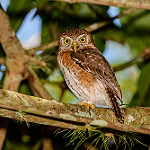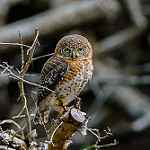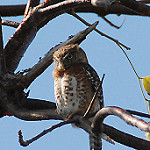Content for this page researched and created by Isabella Bordonaro.

Cuban Pygmy Owls, or Glaucidium siju, are found exclusively in Cuba (Birdlife). They are endemic, which means they are found nowhere else in the world other than Cuba. G. siju belongs to the family of Strigidae (The Website of Everything). The G. siju are the only Galucidium owl found in Cuba (Weick). They are very small owls; they can even be considered the smallest owls in the world. The size of the owl varies by species (Johnson). The Cuban Pygmy owl is so small, that is often referred to as an owlet (Johnson). The owl has a chest that is mostly white, with vertical bars of alternating light and dark brown patches that extend to its wings (Birdlife). The head is dark brown with tufts of white, and the owl has markings on the back of its head that look like dark, menacing eyes (Birdlife). This adaptation of “eye” markings is meant to ward off predators of the owl, and also scare the owl’s prey (Wildlife of the Caribbean). G. siju’s flight feathers are barred light and dark (Mikkola). On the underbelly of the G. siju, it has off-white and barred brown (Mikkola). They have a plain whitish zone from throat to belly (Weick).
G. siju can be found in two color morphs. There is the relatively rare red morph, and the more common grey brown morph (Planet of Birds). The two color morphs for G. siju are considered to be independent of age or sex (Lin). This trend of two color morphs is seen in 7 different types of Glaucidium owls, and depends on age and sex for the other species (Lin). G. siju has a small rounded head, no ear tufts, and large yellow eyes (Planet of Birds). They have short, feathered, yellow feet. (Wildlife of the Caribbean). The claws are horn with darker tips (Weick). The bill of G. siju is yellowish-horn (Weick). G. siju does not have ear tufts because it is a diurnal owl (Perrone). Diurnal meaning that the owls are active in the day. Ear tufts are structures designed to increase the acuity of hearing (the hunting sense more commonly employed by nocturnal owls). A diurnal owl will use vision to augment its hearing during hunting. The females will most likely weigh more than the males (Konig). The females usually weigh 86-90 g, and the males at 55-57g (Weick). The wing length for males is 84- 94mm and for the female wing length is 95-105 mm (Pyle). The bill length is 10 to 13mm (Weick). The short tail of G. siju, usually 54-73mm, is usually twitched sideways (Rafaelle).The tails have 5 or 6 narrow pale bars (Weick). The females are more commonly a reddish brown plumage, and the males have a greyish brown plumage (Pyle).

G. siju mates primarily in the dry season (Holt). The females will lay 3-4 white eggs, and the female will incubate the eggs (Holt). G. siju uses abandoned nests to nest in, or will also use natural tree cavities (Johnson). While mating, the male’s wings vibrate rapidly (Walkinshaw). G. siju has 3 subspecies (Kirwan). One of theses subspecies is G.s. vittatum, which is endemic to the Isle of Pines (Mikkola). The fact that the G.s. vittatum is so different from the G.siju, but so close in geological nature (Mikkola). G.s. vittatum are more distinctly barred (Weick). The wing of the males is 95mm, the females 102-110mm (Weick). In G.s vittatum, the females are still larger than the males (Weick). Juveniles have downy plumage with unmarked backs, streaked underpants, and indistinct crown spots. Juveniles with this description can be aged in the hatching year (Pyle). Birds in active molt can be aged after the hatching year, and birds that are not molting, and have no juvenile plumage cannot be reliably aged (Pyle). Juveniles resemble adults, except for their unspotted crown (Mikkola).

G. siju are more active in the day than many other owl species (Birdlife of the Caribbean). They are not strictly nocturnal (Birdlife). G. siju are easily seen and heard in the day time, they are considered diurnal (Kirwan). G. siju do not hoot, like most owls (Wildlife of Caribbean). Their whistle sounds like a “jiu” at short intervals, or rapidly repeated (Holt). When in alarm, both sexes give a rapid and accelerating series of high pitched squeaky sounding notes (Kirwan). The male’s song is a series of equally spaced single notes at intervals of 4 seconds. The notes are a “tew tew tew” sound (Konig). The female’s song is more rapid “weweehittittrr”, this rapid call can also be heard from the males (Konig). Both sexes can also give a call that sounds like a series of bell-like ringing, like a whoip or pop (Mikkola). The call of G. siju is most often heard at the break of dawn, or at dusk (Walkinshaw). G. siju is strictly carnivorous, eating insects, lizards, small mammals, or other small birds (Holt).

G. siju makes its homes in forest habitats across Cuba (Birdlife). It can live in dry forests, moist forests, and heavily degraded former forests (Website of Everything).They live from sea level up to 1500 m. (Weick). They are specialist owls that will use small portions of the available habitat, and they may require specific management in areas of high forest destruction (Ibarra). If resources in an area are weak, you will not find many G. siju owls, they will attempt to find better habitats (Ibarra). They are the most common of the Cuban owls (Planet of Birds). Even though the G. siju is the most common, they can often be difficult to spot (Eaton). The Cuban Pygmy Owl can also be seen in the Isle of Pines or Isla de la Juventud (Mikkola). The G. siju is locally common, but not well studied (Mikkola).

The Cuban Pygmy Owl is endemic to Cuba (Cuban Pygmy Owl). They have the most limited range (Ginn). On the ICUN list, they are considered of least concern (Birdlife). The habitat destruction and disturbance are the primary threats to this owl, and this inhibits the productivity of breeding and the overall survival of the bird species (Eberly). Cuban pygmy owls do not migrate, since it is endemic it never leaves Cuba (Konig).
Works Cited
General
Birdlife of Cuba: Cuban Pygmy Owl. International Expeditions. 26 July 2015. Web. 29 Sept. 2015.
Cuban Pygmy Owl. Cuban Pygmy Owl. The Website of Everything, 2010. Web. 15 Sept. 2015.
Cuban Pygmy-owl (Glaucidium Siju). Cuban Pygmy-owl (Glaucidium Siju). 2005. Web. 29 Sept. 2015.
Cuban Pygmy Owl (Glaucidium Siju). Planet Of Birds. 7 Sept. 2011. Web. 15 Sept. 2015.
Ginn, Howard. Little, Pygmy and Elf Owls. Owls of the World: Their Evolution, Structure and Ecology. New York: E.P Dutton &, 1973. 164-85. Print.
Holt, D.W., Berkley, R., Deppe, C., Enríquez Rocha, P., Petersen, J.L., Rangel Salazar, J.L., Segars, K.P., Wood, K.L. & Kirwan, G.M. “Cuban Pygmy-owl (Glaucidium Siju).” Handbook of the Birds of the World Alive, 2014. Web. 15 Sept. 2015.
Johnson, Sibylle. Pygmy Owls. Beauty Of Birds. Web. 29 Sept. 2015.
Kirwan, Guy M. Cuban Pygmy-Owl (Glaucidium Siju) – Neotropical Birds. Overview. Cornell Lab of Ornithology, 2010. Web. 15 Sept. 2015.
Konig, Claus, and Friedhelm Weick. Owls of the World: A Photographic Guide. Second Edition: Yale University Press, 2008. Print.
Mikkola, Heimo. Owls of the World: A Photographic Guide. Buffalo: Firefly, 2012. Print.
Scientific
Eaton, Stephen W. “Wood Warblers Wintering in Cuba” The Wilson Bulletin. (1953): 171. Web. 8 Oct 2015.
Eberly, Chris. “Defending the Stepping Stones of Migration.” (n.d.): n. pag. American Birding. 2002. Web. 27 Sept. 2015.
Ibarra, José Tomás, et al. “Occurrence Patterns And Niche Relationships Of Sympatric Owls In South American Temperate Forests: A Multi-Scale Approach.” Forest Ecology & Management 331. (2014): 281-291. Wildlife & Ecology Studies Worldwide. Web. 29 Sept. 2015.
Lin, Wen-Loung, Si-Min Lin, and Hui-Yun Tseng. “Colour Morphs in the Collared Pygmy Owl Glaucidium Brodiei Are Age-Related, Not a Polymorphism.” Ardea. (2014): 90-95. BioOne. Web. 27 Sept. 2015
Perrone, Michael Jr. “Adaptive Significance of Ear Tufts in Owls” The Condor. 83.4. (1981). JSTOR. Web. Sept. 2015.
Pyle, Peter, Amy McAndrews, Pilar Velez, Robert L. Wilkerson, Rodney B. Seigel, and
David F. DeSante. “Molt Patterns and Age and Sex Determination of Selected Cuban Landbirds.” Journal of Field Ornithology. 30 Apr. 2003. BioOne Online Journals. Web. 15 Sept. 2015.
Raffaele, Herbert, James Wiley, Orlando Garrido, Allan Keith, and Janis Raffaele. “Species Accounts and Color Plates.” Birds of the West Indies. Princeton University Press, 2003. 16-203. JSTOR. Web. 27 Sept. 2015.
Raffaele, Herbert A, James W. Wiley. “Birds.” Wildlife of the Caribbean. Princeton University Press, 2014. 100-95. JSTOR. Web. 27 Sept. 2015.
Walkinshaw, Lawrence H., and Bernard W. Baker. “Notes on the Birds of the Isle of Pines, Cuba.” The Wilson Bulletin. Sept 1946. JSTOR. Web. 27 Sept 2015.
Weick, Friedhelm. “Owls (Strigiformes) Annotated and Illustrated Checklist”. Springer Berlin Heidelberg, 2006. SpringerLink. Web. 27 Sept. 2015.
Image References
Flickr. Yahoo!, n.d. Web. 29 Sept. 2015.
<https://www.flickr.com/search/?text=cuban+pygmy+owl&license=2%2C3 %2C4%2C5%2C6%2C9>.
(use via creative commons)
- Cuban Pygmy owl on cut branch (Allan Hopkins)
- Cuban pygmy owl on branch with green leaves (Allan Hopkins)
- Close up of Cuban Pygmy Owl (Allan Hopkins)
- Cuban pygmy owl on bare tree branch (Carol Foil)
- Plump pygmy owl on tree branch (Francesco Veronesi)